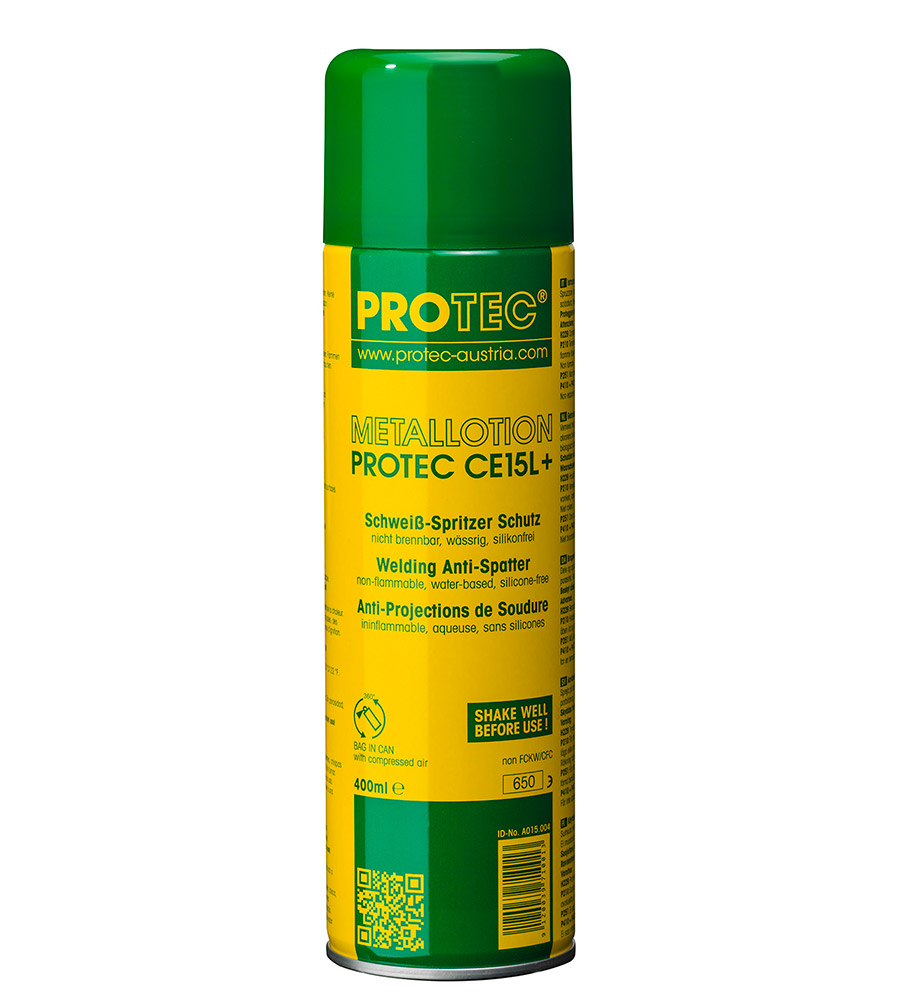

Undesired side effects in connection with the use of anti-spatter products are reported regularly – also in “der praktiker”. On the one hand, reference is made to after-effects, such as coatingfailures, e.g. in galvanising processes (zinc-coating) and, on the other hand, to fireaccidents with flammable products (see picture).ng Spatter without undesired side effects
Originally only for nozzle
Originally Anti-Spatter products were developed to protect the gas-nozzle against firmly adherent spatter during metal-gas-shield-welding. During the nineties of the last century, the products offered at the time had to take into account the prohibition of CFCs. Since then, besides pastes water- and oil-based products have been offered. They mostly use flammable liquid gas as propellant to achieve the desired fine spray-result and flammable solvents to keep the drying time as short as possible. Due to the fact that protection against spatter can also be useful on the work piece or the jig, there is a wide range of application for Anti-spatter aerosols. However, most of the sprays offered do not meet the increased requirements. While the important criterion of the over-welding quality can be evaluated directly at the welder’s workplace, there are further, hidden risks of critical errors. During over-welding a heat affected zone develops next to the welding seam – the most critical zone for the subsequent coatingprocesses (picture below).
Wetting failures during coating – e.g. in hot dip galvanising often give rise to unpleasant discussions as to the responsibility for the failure between the galvaniser and the steel constructor. The flammability of many Anti- Spatter sprays is another dangerous side effect. Anti-Spatter aerosols in metal cans are often glycol-based and contain liquid gas as propellant (such as the gas butane, used for lighters). If such a thinwalled can stands, for instance, on earthing of the work piece, one should not be surprised if it inflames when the welder touches it with the electrode or a spatter strikes through the thin-walled can.
Is an all-purpose Anti-Spatter possible?
The technical and safetyrelated requirements for Anti-Spatter products are numerous:
Besides flammable products, aerosols labelled as “Organic” came to the market. They were praised for being bio degradable, for being produced from renewable resources and using nonflammable propellants. The aerosols often carried the note “silicone-free”, which was to stand for trouble-free coatingprocesses.
These products complied with the need for higher safety – but how about their effectiveness and side effects?
The steel-constructors were partly unsatisfied with the effectiveness as to spatter protection, frequently criticized the poor proportioning and the rather long drying time. Additionally coating-failures arose with some of these products (see picture above). The solution for these unfavourable side effects is the Anti-Spatter product “METALLOTION PROTEC CE15L” – an optimised allpurpose Anti-Spatter lotion for nozzle, jig and work piece. The product is an emulsion made of vegetable based triglyceride in water. It was developed in 1994 and first launched in the Austrian market. “METALLOTION PROTEC CE15L” quickly gained the approval of reputable companies of the metal working industry.
Since exports started in 1997, it has been approved by most automotive manufacturers around the world. Moreover its range of application encompasses, apart from the entire steel construction industry, also cranemanufacturing and shipyards. In these industries the product is used successfully as Anti-Spatter for MAG-welding processes, spot-welding, laser-welding and lasercutting. The initially mentioned requirements are fulfilled completely; on top of that, the thin film of the applied product acts as temporary corrosion protection. Even overdosing does not cause porosity in the welding seam, which sometimes happens with other products (see bottom left picture). Even wet parts can be over-welded without porosity, as confirmed by the welding laboratory “Schweißtechnische Zentralanstalt” in Vienna.

In a welding laboratory of the DVS (German Association for Welding Technology) these analyses have been validated recently. There the welders were able to wipe off the spatter without difficulty, simply using their gloves. In addition they mentioned the pleasant smell of lemon evaporating from the puddles caused by the overdosed product due to the welding heat. The pertaining safety data sheet of this nonhazardous Anti-Spatter spray contains no indication that keeping the spray at the welder’s workplace might be forbidden. The product “METALLOTION PROTEC CE15L” is available in 10 litre cans for self-filling of manual trigger pumps, refillable compressed air spray-cans and/or automatic dosing units.
Additionally, 400ml aerosol cans with “Bagon- Valve”-technology are offered. In this case the product is inside a bag in the spray can. Thus the compressed air used as propellant does not get into contact with the product, which extends its shelf life
Copyright 2024 PROTEC® Trading GmbH. All rights reserved.